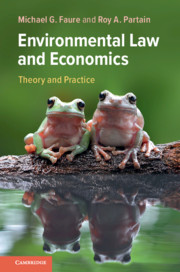Book contents
- Environmental Law and Economics
- Environmental Law and Economics
- Copyright page
- Contents
- Preface
- Acknowledgements
- Abbreviations
- 1 Introduction
- 2 Environmental Harm and Efficiency
- 3 Property Rights Approach to Environmental Law
- 4 Environmental Standard Setting
- 5 Principles of Environmental Law and Environmental Economics
- 6 Pricing Environmental Harm
- 7 Market-Based Instruments
- 8 Liability Rules
- 9 Environmental Regulation
- 10 Environmental Crime
- 11 Insurance for Environmental Damage
- 12 Compensation for Environmental Damage
- 13 Environmental Federalism
- 14 The Role of Environmental Law in Developing Countries
- 15 Epilogue
- References
- Index
11 - Insurance for Environmental Damage
Published online by Cambridge University Press: 13 September 2019
- Environmental Law and Economics
- Environmental Law and Economics
- Copyright page
- Contents
- Preface
- Acknowledgements
- Abbreviations
- 1 Introduction
- 2 Environmental Harm and Efficiency
- 3 Property Rights Approach to Environmental Law
- 4 Environmental Standard Setting
- 5 Principles of Environmental Law and Environmental Economics
- 6 Pricing Environmental Harm
- 7 Market-Based Instruments
- 8 Liability Rules
- 9 Environmental Regulation
- 10 Environmental Crime
- 11 Insurance for Environmental Damage
- 12 Compensation for Environmental Damage
- 13 Environmental Federalism
- 14 The Role of Environmental Law in Developing Countries
- 15 Epilogue
- References
- Index
Summary
Insurance has two basic theoretical motivations. First, for those parties holding a risky asset to purchase a commodity that reduces the overall expected risk of the two assets, being the original asset and the asset of the insurance policy. Insurance policies are available in various forms on the market, but two of the main types of policies for environmental accidents are first-party (damage to self and own assets) and third-party (damage to other parties and their assets) liability insurance. Moral hazard contains the idea that if you assume the risk for someone else, then they no longer face the costs of those risks and thus are more likely to undertake those risks. Market capacity to supply the necessary volume of insurance policies and to be able to pay them out when needed can be reinforced with several tools, including forms of co-insurance, reinsurance, and pooling. Again, it bears repeating that while some injuries, like a wrecked car, might be remedied by cash payouts, this is not often the case for material environmental injuries. Thus, the creation of moral hazard for environmental insurance policies, both first-party and third-party, is a serious concern.
Keywords
- Type
- Chapter
- Information
- Environmental Law and EconomicsTheory and Practice, pp. 233 - 252Publisher: Cambridge University PressPrint publication year: 2019
- 1
- Cited by



